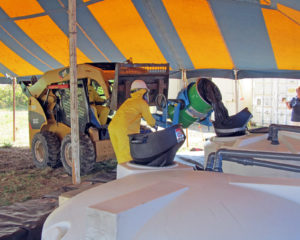Environmental Remediation Doesn’t Have to Be a Headache
If you have your eye on a property that may have contaminated soil, water, or vapors, a little research can go a long way in making sure you’re not blindsided by any necessary remediation work. But if cleanup is required, don’t let it scare you off. With a knowledgeable environmental consultant, your property can soon become safer and cleaner and realize its full potential. Here are some common questions we hear from our clients.
What is due diligence, and why is it important before we buy or take ownership of a property?
In the most basic sense, due diligence is looking at a property and understanding what you are buying. In the environmental world, this entails understanding the environmental risks. Without proper environmental due diligence before buying, you may be left with liabilities associated with environmental problems. We’ve seen many times where property is sold or given to a new owner without having due diligence conducted, and the new owner is obligated to pay the cost of properly addressing environmental issues. This issue extends beyond private buyers; municipalities can often fall into this trap, though they may have other tools to limit their liabilities.
How can I tell if my site is contaminated?
Contamination is underground in soil or groundwater, which is not always apparent to the naked eye. A Phase 1 environmental site assessment (ESA) provides a look back at the history of the site and current conditions and includes a proper database review to identify recognized environmental concerns. If the Phase 1 ESA determines past or current activities have the potential for contamination, a Phase 2 ESA will look for the absence or presence of contamination using subsurface exploration techniques along with field and laboratory sampling and analysis. The results indicate what contamination may be present and at what levels. This provides a base for how those issues may be addressed and if it is appropriate to continue along the property acquisition path.
How are different contaminants handled?
Contamination is managed in accordance with regulations that are based on current or future site use. Surficial soil contamination is often managed by either capping it with clean soil or an impervious surface such as a parking lot or through proper disposal methods. Groundwater contamination from a site release may require in-situ remediation techniques or possibly natural attenuation (i.e., let nature break down the contaminants); this will depend on many factors such as downstream wells, the type of contamination, and the levels of contamination. Vapors can be managed by sub-slab building mitigation systems that allow venting to occur beneath the lowest floor.
If my site is contaminated, what will I be required to do to remediate it?
 Protecting the health and welfare of people and the environment may require a very rapid response or may require a measured, less expensive approach. We try to match the solution to the issue in the most cost-effective way. One example is finding ways to properly manage contaminated soil on site in an approved and safe way so our clients aren’t paying to take it to a landfill, which can be an expensive proposition. If on-site treatment of soils or groundwater is required, we may recommend mixing appropriate chemicals into the source area to break down the contaminants and accelerate the treatment. This approach was implemented at a former musical instrument factory. We pumped potassium permanganate into the groundwater, which oxidized the contaminants of concern (chlorinated VOCs) and improved water quality at the release location. Other solutions are often available, depending on the problems.
Protecting the health and welfare of people and the environment may require a very rapid response or may require a measured, less expensive approach. We try to match the solution to the issue in the most cost-effective way. One example is finding ways to properly manage contaminated soil on site in an approved and safe way so our clients aren’t paying to take it to a landfill, which can be an expensive proposition. If on-site treatment of soils or groundwater is required, we may recommend mixing appropriate chemicals into the source area to break down the contaminants and accelerate the treatment. This approach was implemented at a former musical instrument factory. We pumped potassium permanganate into the groundwater, which oxidized the contaminants of concern (chlorinated VOCs) and improved water quality at the release location. Other solutions are often available, depending on the problems.
What is the best outcome for my contaminated property?
When we look at remediating a property, the main goals are protecting the health and welfare of people and the environment, as well as limiting your liabilities and bringing an unused property back to life. Some sites that have contamination are sitting idle and are a lost opportunity for the community. We work with owners or developers to identify solutions to the contamination that allow the site to be put back into productive reuse and generate revenue again.
The best outcome is to achieve site closure with the regulatory agency, which denotes a site whose issues have been properly addressed, and then find a way to reuse the site. We can often find grants to help with activities that range from site investigation to cleanup to support those goals. When that happens, the community, the owner, and the environment all end up winners.
For questions regarding environmental assessments, remediation planning and implementation, brownfield redevelopment, and solid waste management, reach out to our environmental team.

Post a comment: